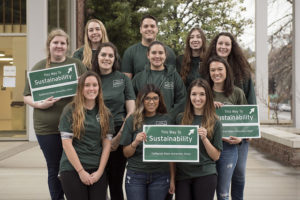On August 28, 2019, the California State University, Chico President Gayle Hutchinson unveiled a new mission and vision for the university, as well as key components of the school’s new Strategic Plan. Together, they will shape the future of CSU, Chico as an academic leader of the global restoration economy for years to come.
At the heart of the school’s new vision and strategy are regenerative agriculture, climate resilience and inclusive economies. This is the sort of academic leadership originally called for in the 2002 book, The Restoration Economy, but which has been so slow to manifest. Government, non-profit, foundation and business leadership in restorative development has largely left academia in the dust. But now, that’s no longer true in Chico, California.
To support this priority, the University’s new Center for Regenerative Agriculture and Resilient Systems, formally approved in May of 2019, will promote regenerative farming practices to reduce greenhouse gasses, build topsoil, restore soil resiliency, increase the sustainability of farms and ranches and address food and water insecurity.
 “With an interdisciplinary team of faculty and staff both on and off campus,” Hutchinson said, “the Center aims to investigate, develop, demonstrate and educate about comprehensive and regenerative practices that both restore and enhance the resiliency of living systems.”
“With an interdisciplinary team of faculty and staff both on and off campus,” Hutchinson said, “the Center aims to investigate, develop, demonstrate and educate about comprehensive and regenerative practices that both restore and enhance the resiliency of living systems.”
As the new mission articulates, “Chico State is the comprehensive university of the North State with a global reach. Through excellence of inquiry, innovation, and experiential learning, we develop students who are critical thinkers, responsible citizens, diverse leaders, and inspired stewards of environmental, social, and economic resources.”
The mission is a true complement for the University’s new vision, which proclaims, “Chico State will be known as a preeminent university solving the unprecedented challenges of the 21st century.”
Under the guidance and leadership of Chief of Staff Brooke Banks, the Strategic Plan will work in tandem with the University’s upcoming new Master Plan, Hutchinson said, as “key elements in our journey toward distinction where students earn a premier education through leading-edge instruction, service and scholarship.”
Intertwined with CSU, Chico’s enduring commitments to academic distinction, a transformative student experience, prominent scholarship and innovation, and a culture of excellence and accountability, the University now has three strategic priorities:
- Equity, diversity and inclusion;
- Civic and global engagement; and
- Resilient and sustainable systems
As she revealed these new priorities at the fall Convocation in August of 2019, Hutchinson encouraged the University community to continue cultivating and nurturing a welcoming and inclusive environment for students, faculty and staff; to address real-world issues of equity, diversity and inclusion; and to promote hiring and retention that contributes to a diverse and inclusive community, while also advocating for the elimination of equity gaps.
Additionally, Hutchinson referenced CSU, Chico’s commitment to encouraging students to pursue civic and global engagement, social justice and connectedness; instilling a culture of philanthropy and civic engagement; and broadening opportunities for civic and global engagement in academic and co-curricular programs.
Finally, turning to one of the University’s core values of sustainability and care for the environment, Hutchinson discussed CSU, Chico’s goal to become a climate-neutral campus by the year 2030; to recognize its responsibility and commitment to helping the communities it serves enhance their abilities to be resilient; and to integrate sustainability and resilience into curriculum, research and campus operations.
This mission, vision and Strategic Plan are the product of an inclusive campus and community planning process that included an expansive and thorough data-collecting process. Team members collected data through early environmental scans, Future Fest meetings, planning workshops and online surveys to produce a strategic vision for CSU, Chico’s future.
“I would argue this was the most inclusive process that Chico State has seen to date,” Hutchinson said. “At its conclusion, the Strategic Plan had over 750 participants generate more than 4,000 lines of data.”
Suggesting the University is entering a new phase of excellence in educating its students, fortifying its position as the North State’s intellectual hub, and forging ahead with a rejuvenated spirit, Hutchinson evoked the image that CSU, Chico is penning a journal of its new future.
“With the new Strategic Plan and physical Master Plan,” Hutchinson said, “we have written the introductory chapter of our institutional journey to prominence.”
All photos are courtesy of CSU, Chico.
See Center for Regenerative Agriculture and Resilient Systems website.

